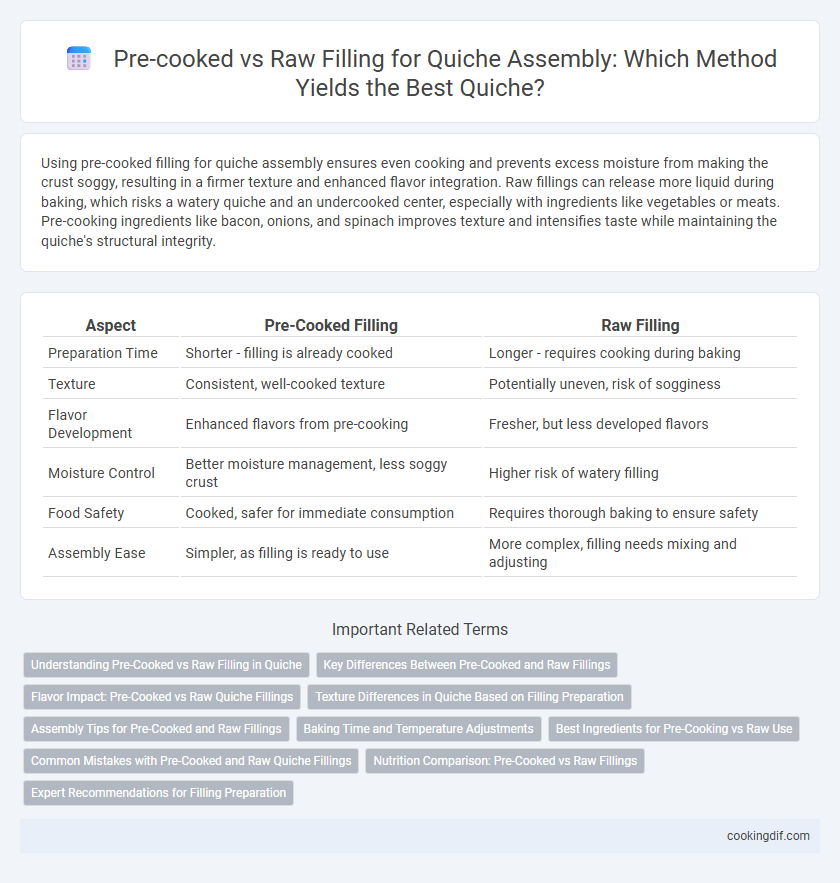Using pre-cooked filling for quiche assembly ensures even cooking and prevents excess moisture from making the crust soggy, resulting in a firmer texture and enhanced flavor integration. Raw fillings can release more liquid during baking, which risks a watery quiche and an undercooked center, especially with ingredients like vegetables or meats. Pre-cooking ingredients like bacon, onions, and spinach improves texture and intensifies taste while maintaining the quiche's structural integrity.
Table of Comparison
| Aspect | Pre-Cooked Filling | Raw Filling |
|---|---|---|
| Preparation Time | Shorter - filling is already cooked | Longer - requires cooking during baking |
| Texture | Consistent, well-cooked texture | Potentially uneven, risk of sogginess |
| Flavor Development | Enhanced flavors from pre-cooking | Fresher, but less developed flavors |
| Moisture Control | Better moisture management, less soggy crust | Higher risk of watery filling |
| Food Safety | Cooked, safer for immediate consumption | Requires thorough baking to ensure safety |
| Assembly Ease | Simpler, as filling is ready to use | More complex, filling needs mixing and adjusting |
Understanding Pre-Cooked vs Raw Filling in Quiche
Pre-cooked filling for quiche ensures even cooking and prevents excess moisture, resulting in a firmer texture and enhanced flavor integration. Raw filling, often used for vegetables and proteins, requires careful balance to avoid undercooking or sogginess, relying on the quiche's baking process to achieve proper doneness. Understanding the moisture content and cooking times of ingredients is crucial for selecting between pre-cooked and raw fillings to optimize quiche texture and taste.
Key Differences Between Pre-Cooked and Raw Fillings
Pre-cooked fillings for quiche offer a more controlled texture and flavor development, as ingredients like vegetables or meats are partially or fully cooked before being combined with the custard mixture, reducing water content and preventing sogginess. Raw fillings rely on the baking process to cook ingredients, which can result in uneven cooking and moisture release, potentially making the crust less crisp. Choosing between pre-cooked and raw fillings significantly impacts baking time, texture consistency, and overall taste quality in quiche preparation.
Flavor Impact: Pre-Cooked vs Raw Quiche Fillings
Pre-cooked quiche fillings develop deeper, more concentrated flavors as ingredients caramelize and moisture reduces during sauteing or roasting, enhancing the overall taste profile of the quiche. Raw fillings often release more water during baking, which can dilute flavors and affect the quiche's texture by causing a soggy crust or uneven cooking. Choosing pre-cooked fillings allows for better control of seasoning and texture, resulting in a richer and more consistent flavor experience.
Texture Differences in Quiche Based on Filling Preparation
Using pre-cooked fillings in quiche results in a firmer, more defined texture as ingredients like vegetables and meats retain their individual structure after baking. Raw fillings release more moisture during cooking, leading to a softer, custard-like consistency with a more homogeneous bite. Choosing between pre-cooked and raw fillings directly affects the overall mouthfeel and density of the quiche, influencing its texture profile.
Assembly Tips for Pre-Cooked and Raw Fillings
For quiche assembly, pre-cooked fillings ensure even cooking and prevent excess moisture from sogging the crust, making them ideal for custard integration. Raw fillings require precise layering and adequate baking time to fully cook ingredients like vegetables or meat within the custard without overbaking the crust. Using a blind baked crust helps maintain structural integrity regardless of filling type, resulting in a flaky, well-cooked quiche.
Baking Time and Temperature Adjustments
Pre-cooked filling for quiche reduces overall baking time by allowing the custard to set without overcooking the ingredients, typically baking at 350degF for 25-30 minutes. Raw filling requires a longer bake time, around 40-50 minutes at 325-350degF, to ensure the eggs cook fully and the crust achieves a golden brown. Adjusting temperature and duration prevents a soggy crust and ensures even cooking of both filling and pastry.
Best Ingredients for Pre-Cooking vs Raw Use
Using pre-cooked fillings like sauteed mushrooms, caramelized onions, or roasted vegetables ensures moisture control and intensified flavors without risking a soggy quiche crust. Raw ingredients such as fresh spinach or grated cheese release less water and require no pre-cooking, preserving natural texture and vibrant taste in the final dish. Choosing high-quality proteins like pre-cooked bacon or ham combined with raw vegetables maximizes both convenience and taste while maintaining the quiche's structural integrity.
Common Mistakes with Pre-Cooked and Raw Quiche Fillings
Common mistakes with pre-cooked quiche fillings include overcooking ingredients like vegetables or meats, which can lead to dryness and loss of flavor, while raw fillings often cause uneven cooking and watery texture due to excess moisture release. Using raw fillings without proper seasoning and draining can result in a bland, soggy quiche crust. Balancing moisture content and cooking times is essential to achieve a creamy, well-set custard and perfectly textured quiche.
Nutrition Comparison: Pre-Cooked vs Raw Fillings
Pre-cooked fillings for quiche often exhibit slightly reduced vitamin content, particularly heat-sensitive nutrients like vitamin C and some B vitamins, due to the cooking process. Raw fillings retain more natural enzymes and nutrients, contributing to higher antioxidant levels, but may pose food safety risks if not handled properly. The choice between pre-cooked and raw fillings impacts the nutritional profile, with pre-cooked options offering improved digestibility and safety at the expense of some nutrient loss.
Expert Recommendations for Filling Preparation
Experts recommend using pre-cooked fillings for quiche assembly to ensure even texture and thorough cooking, preventing soggy crusts and undercooked centers. Pre-cooked ingredients like sauteed vegetables, browned meats, and caramelized onions release excess moisture, maintaining the quiche's structural integrity during baking. Raw fillings often introduce excess liquid, leading to uneven baking and compromised flavor balance.
Pre-cooked filling vs raw filling for quiche assembly Infographic

 cookingdif.com
cookingdif.com